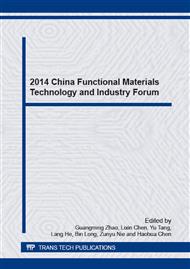[1]
W. K. Lement, R. Willens, P. Duwez, Non-crystalline structure in solidified gold-silion-alloys [J]. Nature, 1960, 187: 869-870.
DOI: 10.1038/187869b0
Google Scholar
[2]
H. Fujimori, S. Mitani, S. Ohnuma, et al. High electrical resistivity behaviour of Fe- and Co-based soft magnetic heterogeneous alloys [J]. Materials Science and Engineering A, 1994, 8: 181-182.
DOI: 10.1016/0921-5093(94)90765-x
Google Scholar
[3]
H. H. Yan, Explosive welding for multi-layer amorphous ribbons [D]. Dalian University of Technology, (2003).
Google Scholar
[4]
Y. Kawamura, Y. Ohno, Spark welding of Zr55Al10Ni5Cu30 bulk metallic glasses [J]. Scripta Materialia , 2001, 45 : 127-132.
DOI: 10.1016/s1359-6462(01)01003-x
Google Scholar
[5]
B. Li, Z. Y. Li, J. G. Xiong, Laser welding of Zr45Cu48Al7 bulk glassy alloy [J]. Journal of Alloys and Compounds, 2006, 413: 118-121.
DOI: 10.1016/j.jallcom.2005.07.005
Google Scholar
[6]
Y. Yokoyama, N. Abe, K. Fukaura, Electron-beam welding of Zr50Cu30Ni10Al10 bulk glassy alloys[J]. Materials Science and Engineering A, 2004, 375-377: 422-426.
DOI: 10.1016/j.msea.2003.10.225
Google Scholar
[7]
H. S. Shin, J. S. Park, Y. C. Jung, Similar and dissimilar friction welding of Zr -Cu -Al bulk glassy alloys [J]. Journal of Alloys and Compounds, 2009, 483: 182-185.
DOI: 10.1016/j.jallcom.2008.07.231
Google Scholar
[8]
Z. Q. Zhu, Z. H. Wu, J. H. Fan, Research and Prospect of ultrasonic metal welding [J]. Welding Technology, 2010, 39: 1-6.
Google Scholar
[9]
H. Kreye, M. Hammerschmidt, G. Reiners, Ultrasonic welding of metallic alloy glass to copper [J]. Scr. Metall, 1978, 12: 1059-1061.
DOI: 10.1016/0036-9748(78)90025-x
Google Scholar
[10]
M. Maeda, Y. Takahashi, M. Fukuhara, Ultrasonic bonding of Zr55Cu30Ni5Al10 metallic glass [J]. Materials Science and Engineering B, 2008, 148: 141-144.
DOI: 10.1016/j.mseb.2007.09.028
Google Scholar
[11]
B. Li, C. Xia, K. L. He, Research of amorphous alloy crystallization curve [J]. Rare Metal Materials and Engineering, 2009, 38: 447-450.
Google Scholar
[12]
H.G. Read, K. Mono, A.P. Tsai, et al. Preliminary atom probe studies of PdNi (Cu) P supercooled liquids [J]. Materials Science and Engineering A , 1997, 223-228: 453-457.
DOI: 10.1016/s0921-5093(97)80056-1
Google Scholar
[13]
Y. Kawamura, T. Shibata, A. Inoue, et al. Workability of the supercooled liquid in the Zr65Al10Ni10Cu15 bulk metallic glass [J]. Acta Mater, 1998, 46: 253-263.
DOI: 10.1016/s1359-6454(97)00235-8
Google Scholar
[14]
Y. Kawamura, Y. Ohno, Superplastic bonding of bulk metallic glasses using friction [J]. Scripta Materialia, 2001, 45: 279-285.
DOI: 10.1016/s1359-6462(01)01025-9
Google Scholar
[15]
O. Haruyama, H. M. Kimura, A. Inoue, Thermal stabilities of some glassy metals with a wide supercooled liquid region [J]. Materials Science and Engineering A, 1997, 226-228: 209-212.
DOI: 10.1016/s0921-5093(97)80038-x
Google Scholar


